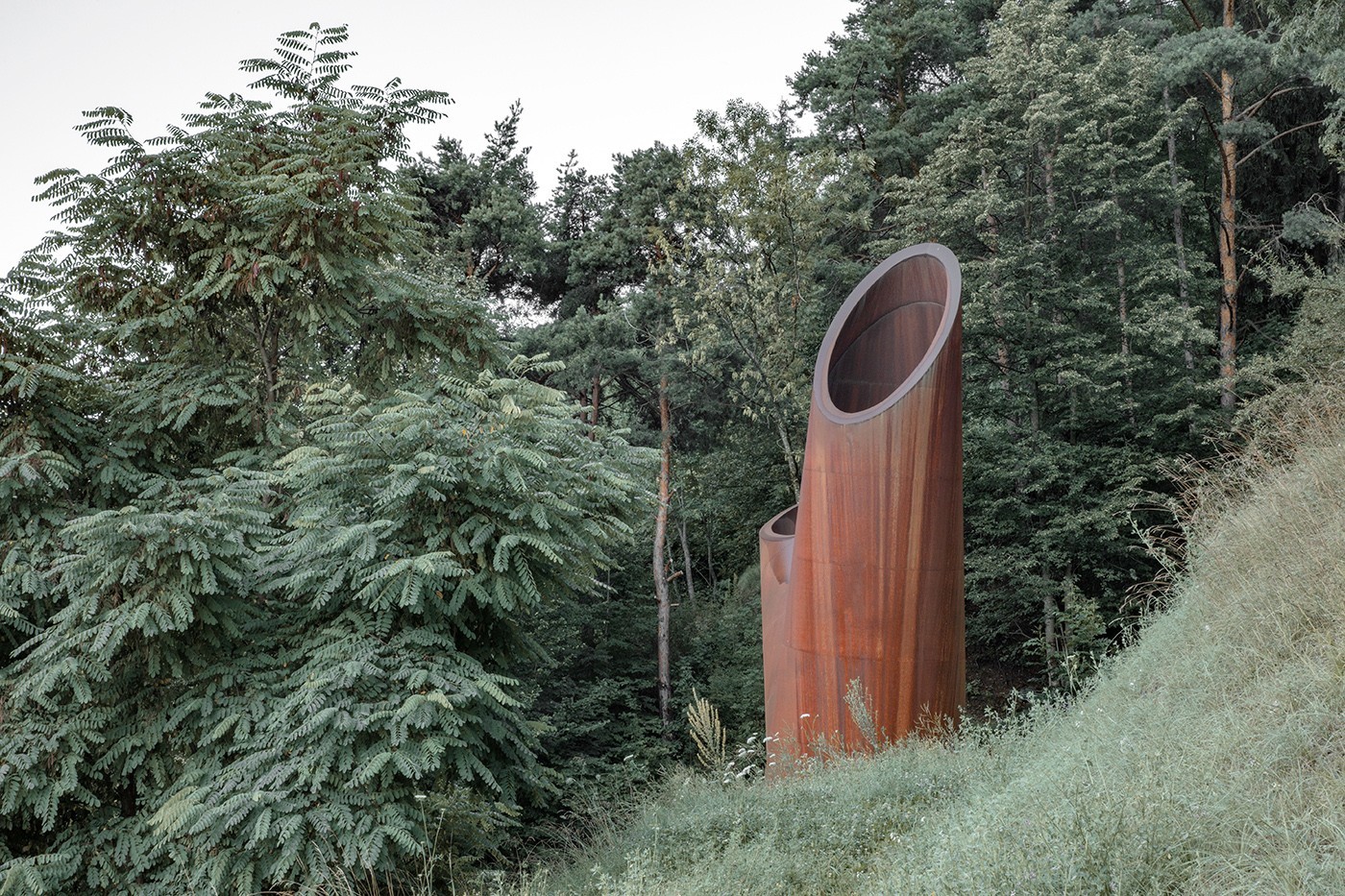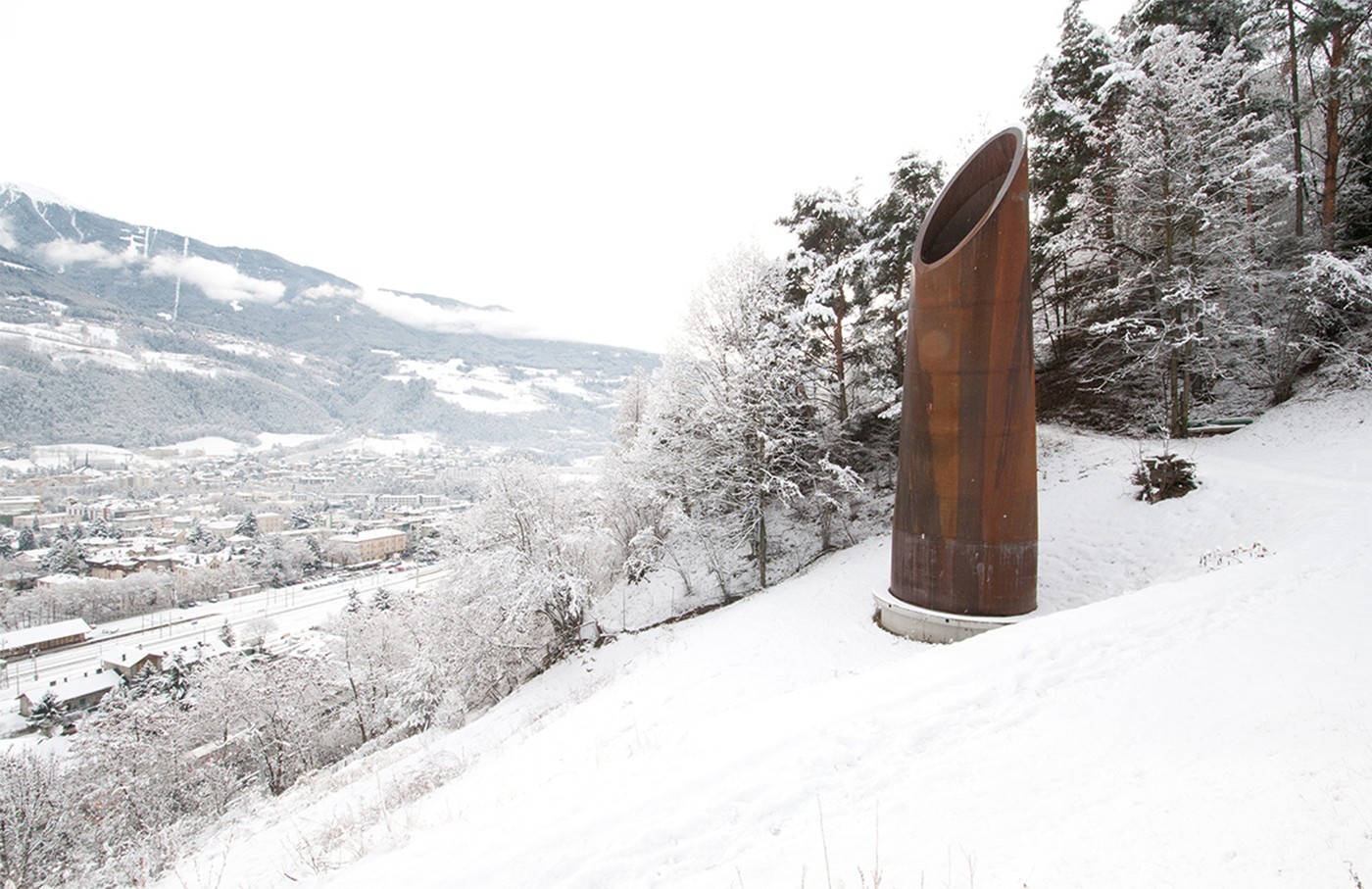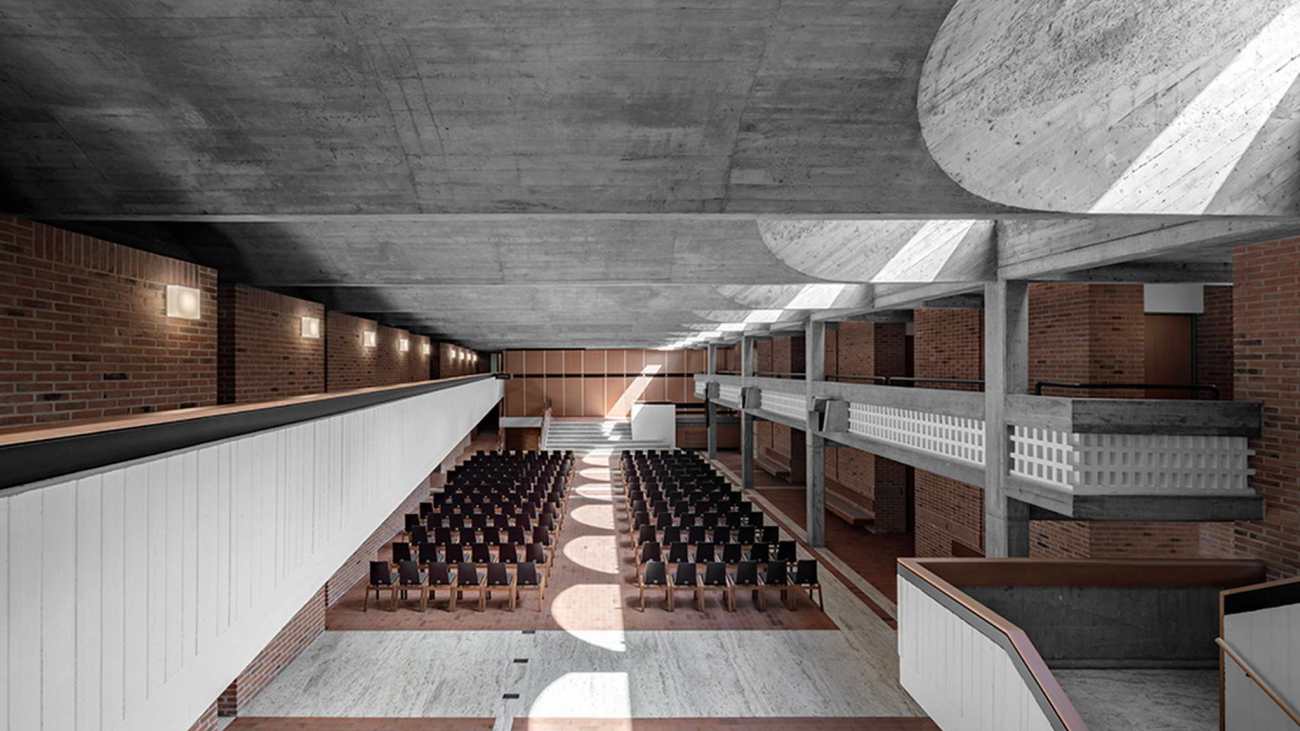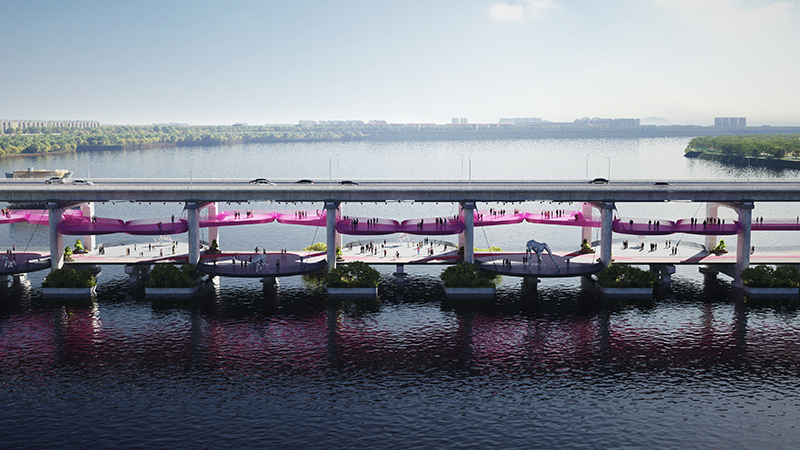| 公司: | MoDusArchitects | 类型: | 景观 |
|---|---|---|---|
| 地区: | 意大利 | 标签: | 交通空间 |
Bressanone (位于意大利)是 Tiroll南部的一个小城市,通向其中心的新通道是对 Bresano- Valeno环路的最新补充。这个基础设施景观项目是由 MoDusArchitects设计的,由一系列相互连接的地下道路组成,项目减少了交通流量,并为这两个城市中心提供替代路线。
A new gateway to the centre of Bressanone (Italy), a small city in South Tyrol, is the latest addition to the Bressanone-Varna Ring Road. The infrastructural landscape project designed by MoDusArchitects www.modusarchitects.com, is composed of a series of connected, largely underground roads that reduce traffic volume and provide an alternate route around both city centres.
新建的环状中央交汇处是项目中与SS12干线重新连接的一部分,靠近Bressanone市中心。开车的人从这条环路出发,穿过一个环岛,通过一个短 U形隧道和两个各自暴露的混凝土入口,到达 Via Roma这条直通城市的主要道路的活动轴线。朝向东方的新入口的雕塑口以弯曲的形式呈现,为最初项目的许多设计介入提供了曲线元素,摆脱了普通基础设施项目古板的形象。
The newly opened central juncture tract of the ring road is the section of the project that reconnects with the main thoroughfare of the SS12 in proximity to Bressanone city centre. Travelling from the ring road, motorists navigate a roundabout and pass through a short U-shaped tunnel along with its two, respective exposed concrete portals to arrive at a shifted axis with Via Roma – the main road leading directly into town. The sculptural mouth of the new portal facing east takes a sinuous form that contributes to the lexicon of curvilinear elements that characterize many of the design interventions of the original project, steering away from the strictly technical or functional vocabulary typically offered by infrastructural projects.
整个设计过程中都需要一系列的干预措施(隧道入口、挡土墙、声屏障、公用变电站、机械结构、通风烟囱和各种标识元素),并以三项简单的设计决定为指导。第一,建筑师力图最大限度地减少地面元素对环境的影响,以同时体现建筑和技术的质量。第二,将这些单元和地下单元概念化,使其成为一种统一的、对应的设计方法,并根据当前场地条件的特殊性进行了调整。第三, Bressanone和 Varna地区形成了一个连续的区域,使得这两个城市不再被看作是不同的环境,而被看作是更大的整体的两个部分。
The design brief called for a series of interventions (tunnel portals, retaining walls, acoustic barriers, service substations, mechanical structures, ventilation chimneys, and various signage elements) along its entire length, and is guided by three simple design decisions. Firstly, the architects sought to minimize the environmental impact of the elements above ground in order to express both an architectural and technical quality. Secondly, these elements and those below ground were conceptualized into a unified, consequential design approach, and were calibrated to accommodate the particularities of the immediate site conditions. Lastly, the Bressanone and Varna tracts were pulled together into one continuum whereby the two townships are no longer conceived as distinct contexts but as two parts of a greater whole.
这个项目呈现出一系列与隧道系统相辅相成的元素——新的入口,而中央交界处的隧道入口则被设想为富有表现力的元素,入口从隐藏的无形公路网络中浮现出来,以不同的速度和尺度表现在分层的城市环境中。
The project presents an inventory of complementary elements integral to the system of tunnels—as new entries, the central junction tunnel portals have been conceived as expressive figures whose raised heads emerge from the buried, unseen networks of roads serving as mediators of the disparate speeds and scales of the stratified urban context.
新增的混凝土部分由骨料和挖掘材料组成,在Brenner基础隧道中施工,该隧道从奥地利的 Innsbruck隧道穿越阿尔卑斯山到达意大利的 Fortezza,全长64公里。入口与裸露的混凝土、落叶松木隔声墙和钢质通风烟囱一起,构成了建筑设计中的重要部分:它们位于景观、基础设施和流动空间的交汇处。这标志着地下与地面之间的界限,它是Bressanone内城市景观的一部分,也是短暂的行车经验的的非凡体验。
The concrete work of the new addition is made of aggregates and excavation materials drawn from the ongoing construction site of the 64km Brenner Base Tunnel traversing below the Alps from Innsbruck (Austria) to Fortezza (Italy). Together with exposedconcrete, larch wooden acoustic barrier walls and cor-ten steel ventilation chimneys, the portals constitute important sites of architectural design: they lie at the intersection of landscape, infrastructure and mobility. These interventions mark the threshold between below ground and above ground, becoming part of the urban landscape of Bressanone, and also defining the fleeting, motorist experience.
MoDusArchitects特别关注噪音排放问题,并采取了诸如Leca-beton墙等多项措施来解决吸声问题。为了更好地解决这些环境问题,研究公路建设行业常用材料的重组挖掘出的解决方案,同时探索新的方法,将简单、低成本的材料结合起来,以弥补规模上的差距,并克服在靠近Bressanone小规模建筑的地方进行建设的困难。
MoDusArchitects paid particular attention to noise emissions and many of the interventions, such as the Leca-beton walls, grappled with sound absorption solutions. Research into the reconfiguration of commonly used materials in the road-building industry unearthed solutions to better address these environmental concerns while exploring new ways to combine simple, low-cost materials that could bridge the gap in scale and overcome the difficulties inherent to building in close proximity to the small scale buildings of Bressanone.
项目下一个也是最后一个阶段预计将于2025年完成,它将延伸到穿越瓦尔纳市中心的最终轨道上,全长8公里。
The next and final segment of the ring road, projected to be completed in 2025, will extend the intervention to its final trajectory past the city centre of Varna for a total length of 8km.
▼项目总图 Master Plan
项目名称:Central Juncture of Bressanone-Varna Ring Road
设计单位:MoDusArchitects
项目地点:意大利 Bressanone
设计团队:Sandy Attia,Matteo Scagnol
项目客户:Department of Infrastructure and Mobility of the Autonomous Province of Bolzano
设计阶段:2015年至2017年
建设阶段:2017年至2020年
竣工时间:2020年6月
土木与结构工程,施工管理:ing. Mario Valdemarin
工程团队:ing. Mario Valdemarin, ing. Dieter Schölzhorn, EUT Energie und Umwelttechnik GmbH, Bergmeister GmbH, Geoconsulting Int.
地下和岩土工程顾问:ing. Mario Valdemarin, ing. DieterSchölzhorn
地质顾问:geol. Alfred Psenner, geol. Icilio Starni
技术系统顾问:Studio Tema Srl (p.i. Mattia Betti)
项目经理:Provincia Autonoma di Bolzano, dott. ing. Umberto Simone
总承包商:PAC S.p.A in ATI with Wipptaler Bau AG and Beton Eisack GmbH
长度:500m(中央关口隧道); 5公里(完成环城公路); 8km(环路全长)
材料:裸露混凝土,Leca-beton,耐候钢,落叶松木材
Project name: Central Juncture of Bressanone-Varna Ring Road
Location: Bressanone (Bolzano, Italy)
Architect: MoDusArchitects (Sandy Attia, Matteo Scagnol)
Client: Department of Infrastructure and Mobility of the Autonomous Province of Bolzano
Design phase: 2015—2017
Construction phase: 2017—2020
Completion: end of June 2020
Civil and Structural engineering, Construction management: ing. Mario Valdemarin
Engineering team: ing. Mario Valdemarin, ing. Dieter Schölzhorn, EUT Energie und Umwelttechnik GmbH, Bergmeister GmbH, Geoconsulting Int.
Underground and geotechnical consultant: ing. Mario Valdemarin, ing. DieterSchölzhorn
Geologicalconsultant:geol. Alfred Psenner, geol. Icilio Starni
Technologicalsystemsconsultant: Studio Tema Srl (p.i. Mattia Betti)
Project manager: Provincia Autonoma di Bolzano, dott. ing. Umberto Simone
General Contractor: PAC S.p.A in ATI with Wipptaler Bau AG and Beton Eisack GmbH
Length: 500m (central juncture tunnel); 5km (completed ring road); 8km (full length of the ring road)
Materials: exposed concrete, Leca-beton (structural light concrete with Leca expanded clay aggregates), cor-ten steel, larch wood
更新日期:2020-07-21 15:44:42
非常感谢 MoDusArchitects 带来的精彩项目, 查阅更多Appreciations towards MoDusArchitects for sharing wonderful work on hhlloo. Click to see more works!




















